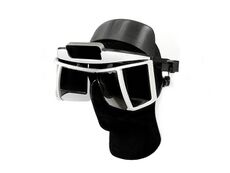Project North Star
Project North Star is an augmented reality headset that was created by Leap Motion.
It is named "North Star" because it represented a guiding direction that Leap Motion wanted to go in.
A northstar headset uses a curved reflector. The headsets typically require calibration to correct for geometric distortions introduced by the reflector.
There are multiple different versions, including the original release, and the Deck X.
Headsets can be partially 3D printed.
A northstar headset requires a computer to connect to using Displayport and USB.
Hardware[edit]
It is based on a reflector style design. It is an optical-see-through head mounted display (OST-HMD).
Project North Star headsets generally use an Intel T265 and a Leap Motion Controller.
The original prototype headsets had a large field of view. The first open-source release shrunk it.[1]
The original reference design specified by Leap Motion uses BOE VS035ZSM-NW0 displays.[2]
Versions[edit]
- Release 1 - internal release[3]
- Release 2 - first public open-source release[3]
- Release 3[3]
- Release 3.1[3]
- Release 3.2[3]
- Deck X[3]
- Northstar Next[3]
History[edit]
Prototype reflectors were 3D printed using VeroClear resin.[1] A secondary set of reflectors were produced using diamond turning from a block of acrylic material.[1] The secondary set of reflectors were coated with a thin layer of silver.[1]
Software[edit]
How to build[edit]
A North Star headset can be built by selecting the right displays and driver board.
Calibration is one of the key steps. Calibration can be done with a calibration rig.
Building with support for hand tracking is not recommended.
References[edit]
- ↑ 1.0 1.1 1.2 1.3 "Our Journey to the North Star". 2018-04-09. https://blog.leapmotion.com/our-journey-to-the-north-star/.
- ↑ "North Star Display (3.5 inch, 1440x1600 pixels, 120fps)". 2020-12-10. https://www.smart-prototyping.com/Display-for-Project-North-Star-3_5inch-1440x1600-pixels%20Promotion%20sale.
- ↑ 3.0 3.1 3.2 3.3 3.4 3.5 3.6 "Project North Star". 2023-06-17. https://docs.projectnorthstar.org/project-north-star.
- ↑ "Esky". 2021-07-18. https://docs.projectnorthstar.org/project-north-star/software/esky.
